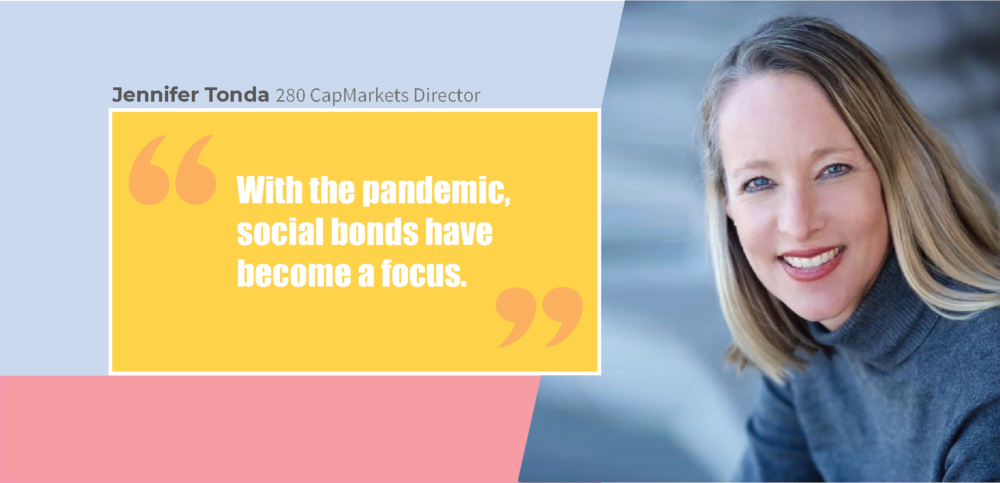- COVID-19 pandemic is leading to increased flow into social and sustainability-linked bonds, according to 280 CapMarkets’ Jennifer Tonda.
- ESG bonds allow fixed-income investors to have a measurable impact on environmental and social issues.
- Green, social and sustainability bond issuance is projected to rise from $204 billion in 2019 to $400 billion this year.
Jennifer Tonda has long been passionate about the earth — fighting global warming, controlling pollution — and gender equality. Now, the director of institutional sales at 280 CapMarkets, is also passionate about letting people know that impact bonds can help combat these problems.
She says the focus on rebuilding after COVID-19, which has bolstered what was already a record flow into bonds that aim to have an environmental, social, and governance impact, is helping get that message out.
ESG investing is now a part of the mainstream, with everyone from individuals to pension and sovereign-wealth funds getting in on the act, and bonds are an easy way to get in on the act, Tonda told Karma. Green bonds attracted the bulk of funds until now, with social and sustainability debt getting less attention, but COVID-19 has changed that.
“With the pandemic, social bonds have become a focus,” Tonda said. “It seems that before, social concerns were overshadowed by environmental considerations. But now, we will need significant funding to help battle the effects of COVID 19 and we are seeing more social bonds issued. The African Development Bank brought a $3.1 billion deal, which is the largest social bond brought to market.”
There were $32 billion of social and sustainability bonds issued in April 2020, according to Morgan Stanley. This was the first month when the value of social and sustainability bonds surpassed green bonds, according to the bank. The boom in social bond issuance contrasts with declines in the fixed-income market overall, where issuance volumes are projected to drop 9% this year, S&P said.
Corporations and governments issued $204 billion worth of green bonds last year, up 50% from $136 billion in 2018, according to data compiled by Bloomberg. Green, social and sustainability debt is projected to climb to $400 billion in 2020, according to Moody’s Investors Service.
“Green and sustainable bond issuance hit a record of $204 billion in 2019, and we are looking at over $400 billion coming to market this year,” Tonda said. “In 2019, the split was 80% green bonds and 20% social bonds and the last few months we have seen the split switch and 60% of new issues were social bonds and 40% were green bonds.”
Investors don’t have to suffer from a reduced yield in order to finance the environmental and social benefits that result from the bonds.
“One common misconception that many have is that you have to give up yield when you invest in green, impact and/or sustainable bonds, but in most cases, you do not don’t have to give up yield, and green bonds trade very similar to traditional bonds,” Tonda said. “Some true impact investors would be willing to give up yield, but it’s often not necessary.”
The ESG fixed-income sector has come a long way since the World Bank issued the first green bond in 2009. This set the template for fixed-income instruments that are designed to raise money for climate and environmental projects. This was followed by the creation of bonds designed to support social and sustainability.
The first green bond “raised awareness for the challenges of climate change,” Tonda said. “Impact investing has really grown in the fixed-income sector. There are different types of green and impact products. Green bonds are where the proceeds are used to fund environmentally friendly projects and impact bonds the proceeds are used to invest in businesses that produce a social benefit.”
ESG bonds offer flexibility to impact investors looking to see their dollars promote sustainability and social justice, Tonda said.
“Everyone wears a different lens when it comes to impact investing and by buying bonds, you can customize it, to meet your goals,” Tonda said. “For example, we have one client that wants a portfolio that focuses on low-income housing bonds, so we can put together a portfolio that focuses just on that. You can make it very individualized.”






















